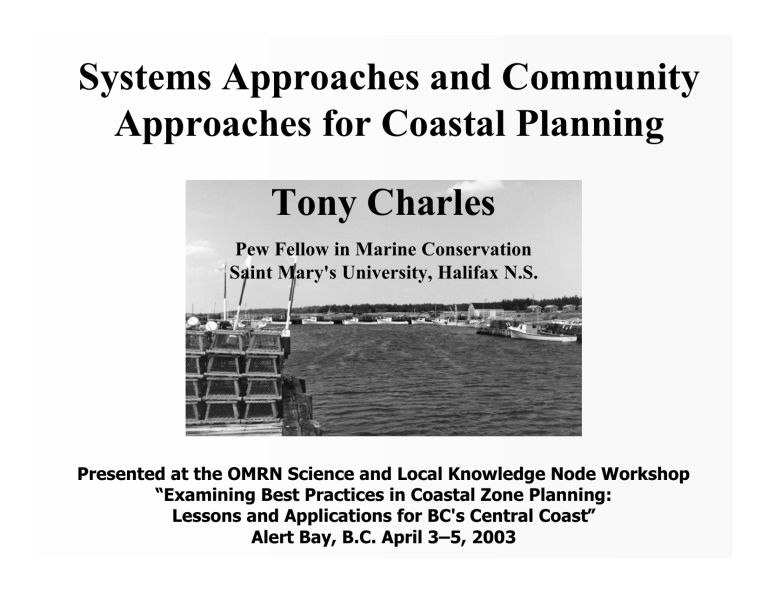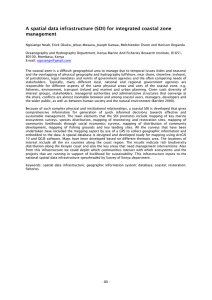Systems Approaches and Community Approaches for Coastal Planning Tony Charles

Systems Approaches and Community
Approaches for Coastal Planning
Tony Charles
Pew Fellow in Marine Conservation
Saint Mary's University, Halifax N.S.
Presented at the OMRN Science and Local Knowledge Node Workshop
“Examining Best Practices in Coastal Zone Planning:
Lessons and Applications for BC's Central Coast”
Alert Bay, B.C. April 3–5, 2003
Five Themes for Coastal Planning
1. Coastal Systems
2. Sustainability, Resilience & Indicators
3. Community-Based Coastal Management
4. Integrated Impact Analysis
5. Networking: The OMRN
#1. Coastal Systems
•
The Natural System :
•
Natural Resources
•
The Coastal Ecosystem
•
The Biophysical Environment
•
The Human System :
•
Coastal Resource Users
•
Households and Communities
•
Social/Economic/Cultural Environment
•
The Resource Management System :
•
Policy and Planning
•
Integrated Coastal Management
•
Development and Research
NATURAL ECOSYSTEM
Community
MANAGEMENT SYSTEM
Policy and
Planning
Resource
Management
Relevant Resources
Habitat
External Forces
(eg. climate change)
External
Environment
Resource
Development
HUMAN SYSTEM
Resource Users
Adapted from A.
Charles, Sustainable
Fishery Systems,
Blackwell Science,
Oxford UK (2001).
1
User
Groups
Resource
Technology
Community
P
2
3
R
C
Processing
& Marketing
(4)
D
M
External Forces
(eg. macroeconomic policies)
Households
Socioeconomic
Environment
W
Resource
Research
External
Forces
(eg. government downsizing)
P = processing
D = distribution
M = market
W = wholesale
R = retail
C = consumers
(1) User conflicts
(2) Technological conflicts
(3) Community economics
and social interactions
(4) Marketing channels
#2. Sustainability, Resilience, Indicators
An integrated view of
Ecological
Sustainability sustainability in coastal areas requires that we pay attention to a range of ecological, socioeconomic, community
& institutional factors.
Socioeconomic Community can use checklists or sets of indicators...
Institutional
Sustainability
(a) Sustainability Indicators
• Ecological Indicators
• Socioeconomic Indicators
• Community Indicators
• Institutional Indicators
• see www.gpiatlantic.org
M EA S U R I N G S U S TA I N A B L E D E V E L O P M E N T
A P P L I C A T I O N O F T H E G E N U I N E PR O G R E SS I N D E X T O N O V A S C O T I A
T H E N OVA S COT I A GPI
F I SH ERI ES & M ARI N E E N VIRON M EN T
A CCOUN T S
A P RE LI MIN ARY S ET OF E COLOGI CAL ,
S OCI OECON OMI C AN D I N STITUTION AL
I N D ICATORS FOR N OVA S CO TIA Õ
F I SH ERIES AN D M ARIN E E N VIRON MEN T
Prepared by:
An thony Charles
H eather Boyd
Amanda Lavers
Cheryl Benjamin
(b) Resilience Indicators
• Resilience is the capability of a system, such as a coastal zone (including ecological, human and management components) to persist or ‘bounce back’ following unexpected shocks to the system
• Desired ingredients of a resilient coastal system:
Resilient ecosystem
Resilient communities
Resilient socioeconomic structure
Resilient management institution
Resilience Indicators (cont’d)
• Debt, Bankruptcies
• Age Structure of Fishers
• Diversified Landings
• Multi-Fishery Access
• Diversified Employment
• Econ. Diversification
• Biodiversity
• Benthic Integrity
1
0.75
0.5
0.25
0
Proportion of License Holders with Multispecies Licences
One
Two
Three +
Year
#3. Community-based
Coastal Management
• The idea: local resource users and their communities should have significant responsibility for management
• “a nested system that reflects in social and policy terms a similarly nested relationship of organisms, species, and associations that is found in ecosystems”
(Uphoff 1998).
• W. Coast Vancouver Island
Aquatic Management Board
• Annapolis Basin, St. Mary’s
Bay Working Groups
(Bay of Fundy)
CBCM : Aboriginal Connections
• Community-based management is the traditional approach in many aboriginal communities;
• But while access to coastal resources is improving, many First
Nations in the Maritimes also seek recognition of the right to involvement in managing local resources;
• A focus on CBCM can help to rectify this, for First Nations as well as non-aboriginal communities...
• With support from the Pew Fellows Program in Marine
Conservation, efforts are underway in Canada’s Maritimes to support grass-roots community-based fishery and coastal management, linking aboriginal & non-aboriginal fishers, communities; and connecting with B.C. communities www.turningthetide.ca
#4. Integrated Impact Analysis:
The Example of Climate Change
Physical Changes (e.g. Sea Level, Temperature)
Á
Biological Implications (e.g. Fish Distribution)
Á
Direct Human Impacts (e.g., Fishing, Tourism)
Á
Induced Human Impacts (e.g., Socioeconomic)
The following chart indicates possible climate change impacts related to coastal areas and fisheries in Canada, from biophysical to fish stock to socioeconomic impacts...
BIOPHYSICAL / FISH IMPACT
⇒
Important salmon stocks from Fraser and southern rivers may decline. In northern BC rivers, salmon productivity may increase.
⇒
SOCIOECONOMIC IMPACT
Distributional impacts: south communities may suffer versus north ones, and capital-intensive fishers may also do relatively well.
Pacific cod abundance likely will be reduced.
Exotic species will be introduced into the Pacific area from the south.
Lower profits, new opportunities. Fishers and communities that are adaptable will do well.
Multi-species licensing policy crucial.
Changes to salinity of the Bras d impact Cape Breton ’
’ Or lakes may s oyster culture industry.
Environmental changes could lead to increased catchability for lobster, scallops and other
Atlantic invertebrates.
Some Arctic species (e.g., sea otter, warmer water fish) could move into new territories.
Cumberland Sound turbot fishery prosecuted from ice surface, and so is vulnerable to changes in ice thickness and distribution.
Storm surges and coastal erosion will affect wetlands (and thus fish habitat).
Highly local impacts on fisheries, aquaculture imply the need to avoid ‘ one-size-fits-all ’ policies, to encourage local management..
Higher profits. Management changes (e.g., decreased trap limits, capacity limits) will be needed to avoid over-exploitation.
Distributional impacts: some lose, some gain, unless licensing allows larger fishing zones.
Investment in new fishing methods may be needed or markets may be lost; some fishers may need to shift to other fisheries.
Loss of habitat on coast could have relatively negative impact on coastal small-boat fishers.
#5. Networking: The OMRN
OCEAN MANAGEMENT RESEARCH NETWORK
• An inclusive Canadian network involving researchers and research users across the country dealing with human uses of the ocean & management of such uses
• Coastal planning and management is a key component
• For more information or to join the OMRN:
www.omrn.ca
Some References
• A.T. Charles, Fisheries management in Atlantic Canada , Ocean and Coastal
Management 35:101-119 (1997).
• A.T. Charles, Beyond the Status Quo: Re-thinking Fishery Management in:
“Re-inventing Fisheries Management”, T. Pitcher, D. Pauly, P. Hart (eds.),
Kluwer (1998).
• A.T. Charles, Living with Uncertainty in Fisheries: Analytical Methods,
Management Priorities & the Canadian Groundfishery Experience , Fisheries
Res. 37:37-50 (1998).
• A.T. Charles, Sustainable Fishery Systems , Blackwell Sci., Oxford UK (2001).
• A.T. Charles et al., The Nova Scotia GPI Fisheries and Marine Environment
Accounts: A Preliminary Set of Ecological, Socioeconomic and Institutional
Indicators for Nova Scotia’s Fisheries and Marine Environment . GPI Atlantic,
Tantallon NS Canada (2002).
• A.T. Charles, The Precautionary Approach and ‘Burden of Proof’ Challenges in Fishery Management , Bulletin of Marine Science 70(2):683-694 (2002).








